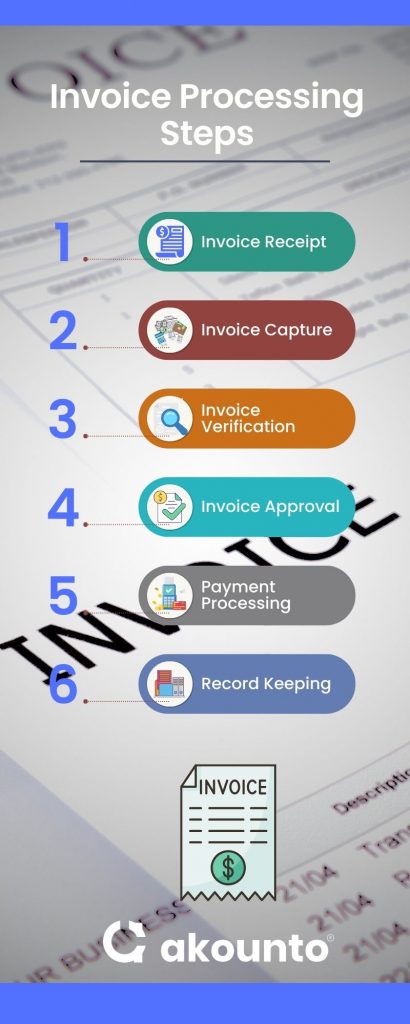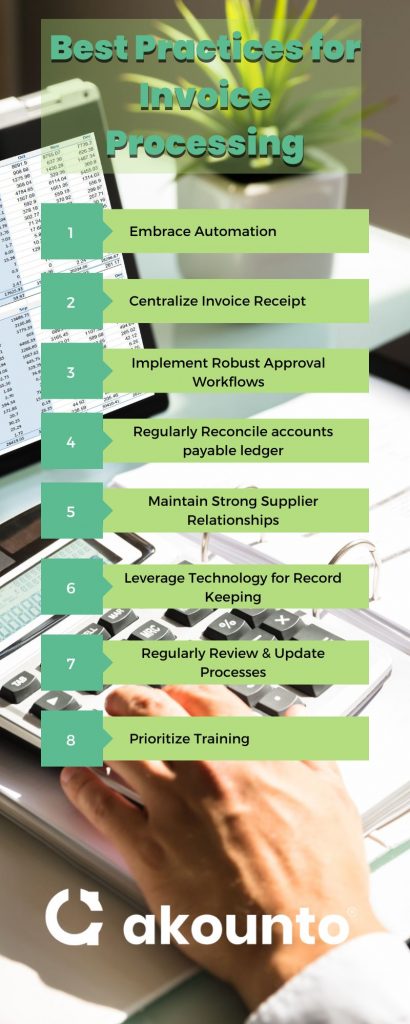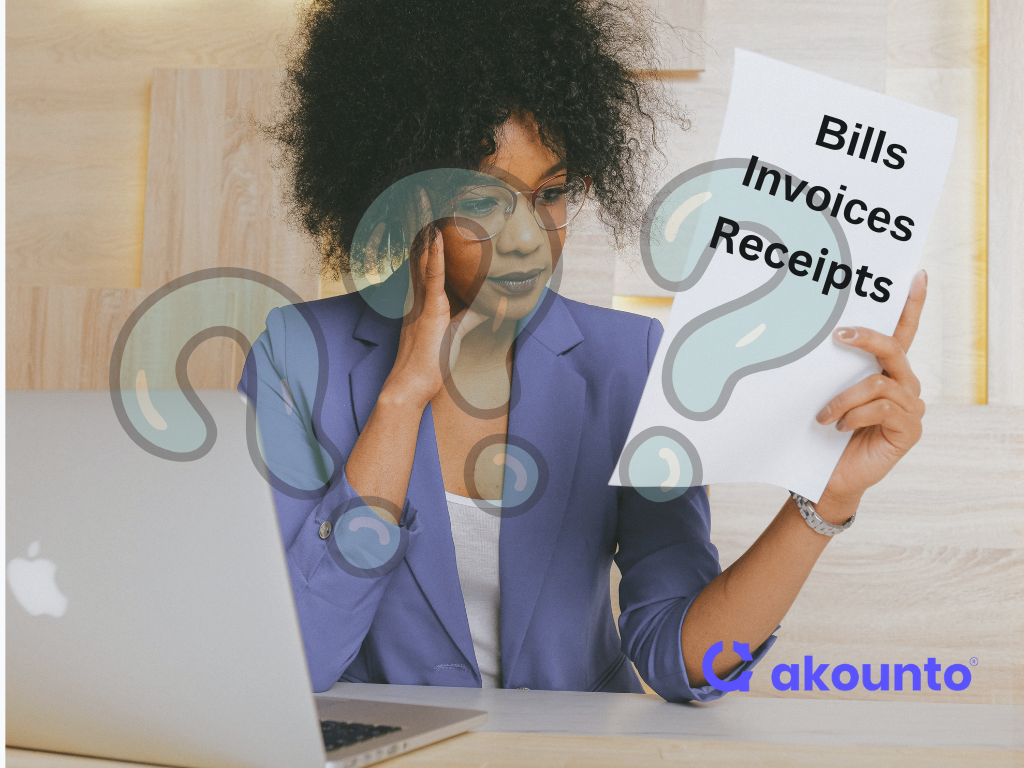Invoice processing is carried out by the accounts payable department, which involves managing supplier invoices from receipt to payment.
What’s covered in the article
Introduction
Traditional invoice processing can be labor-intensive and prone to errors, often involving manual data recording and physical invoices.
Automated invoice processinghas transformed this crucial business function.
Invoice automation software eliminates the need for manual data entry, reduces the risk of duplicate payments, and accelerates the invoice approval process while it saves time and money and enhances accuracy and efficiency.
Understanding invoice processing is essential for anyone running a business, as it plays a significant role in managing accounts payable (AP) and maintaining a healthy cash flow.
With increasing digital solutions, one must keep up with the most recent advances in invoice processing, including automation and software.
Knowledge of invoice processing and workflow automation can be a game-changer for small business owners, entrepreneurs, and freelancers, enabling them to streamline their accounts payable (ap) process and optimize their business operations.
The Process

Processing of invoices is a multi-step procedure that requires meticulous attention to detail. Here’s a breakdown of the typical invoice processing steps involved in the accounts payable workflow:
- Invoice Receipt: The process begins when the accounts payable department receives an invoice. Invoices can arrive in various formats, including paper invoices, PDFs, or electronic invoices.
- Invoice Capture: The next step involves capturing the invoice data. It could be done manually, but many businesses now use invoice automation software to extract the necessary information, reducing the need for manual data recording.
- Invoice Verification: The accounts payable team verifies the invoice details against the purchase order and delivery receipt to ensure accuracy. This step is crucial to prevent duplicate payments and overpayments.
- Invoice Approval: Once the invoice has been verified, it goes through an approval process. The approval workflows may vary depending on the company’s internal policies.
- Payment Processing: After approval, the invoice is ready for payment. Timely payment helps maintain good supplier relationships and can lead to early payment discounts.
- Record Keeping: The final step is recording the transaction in the accounting system. It helps maintain accurate financial records and facilitates easy retrieval of invoice data for future reference.
These procedures can be greatly streamlined by automating the invoice process with an AP automation solution, reducing time spent on manual tasks and decreasing errors. It also allows the accounts payable team to focus on more strategic tasks, enhancing overall productivity.
Benefits
Effective management and tracking of invoices offer numerous benefits that can significantly enhance a company’s operational efficiency and financial health. Here are some of the key advantages:
- Improved Cash Flow Management: Timely processing of invoices allows businesses to take account of their financial obligations, thereby enabling better cash flow management.
- Reduced Errors: Automated payment processing reduces the risk of errors in handling the data manually, such as duplicate payments or overpayments.
- Cost Savings: Automation can lead to substantial cost savings by reducing the time and resources spent on manual processes. It also helps avoid late payment fees.
- Enhanced Supplier Relationships: Prompt payment of invoices contributes to maintaining positive supplier relationships, which can be beneficial for negotiating terms and securing early payment discounts.
- Increased Productivity: By automating the invoice process, the accounts payable function can focus on more strategic tasks, increasing overall productivity.
- Better Compliance: By keeping a detailed audit trail of every transaction, automated invoice processing systems can aid in ensuring compliance with internal and external requirements.
- Greater Visibility: With automated invoice processing software, businesses can gain greater visibility into their AP procedures, enabling them to identify bottlenecks and make informed decisions.
- Scalability: Automated systems can easily handle increasing invoices as the business grows, ensuring efficient accounts payable system.
By leveraging the power of automation in the invoice payment process, businesses can reap these benefits and more, leading to increased operational efficiency and financial performance.
Challenges
Despite its critical role in business operations, payment processing can present several challenges, especially when handled manually. Here are some of the common issues:
Manual Data Entry
Manual handling of invoice data can be time-consuming and prone to errors, leading to issues like duplicate payments and overpayments.
Paper Invoices
Managing physical invoices can be cumbersome and inefficient. It also increases the risk of invoices getting lost or misplaced.
Delayed Approvals
Inefficient approval workflows can delay invoice payments, strain supplier relationships, and result in late payment fees.
Lack of Visibility
It can be hard to track the status of invoices without a centralized system, which results in a lack of transparency in the accounts payable process.
Scalability Issues
Manual invoice processing can become increasingly complex and unmanageable as the volume of invoices grows with the business.
Invoice automation software can address these challenges by streamlining the entire process, reducing manual tasks, and providing greater visibility and control over the ap process.
Journal Entry
In accounting, invoice processing involves a series of journal entries that record the transactions related to the receipt and payment of invoices. Understanding these entries is crucial for maintaining accurate financial records. Here’s a typical sequence of journal entries:
Receipt of Invoice
The AP division enters an invoice as a liability in the company’s books when it is received. The journal entry debits the expense or asset account and credits the Accounts Payable account.
Example: If a business receives an invoice for office supplies worth $500, the journal entry would be:
Office Supplies Expense (Debit) – $500 Accounts Payable (Credit) – $500
Payment of Invoice
The Accounts Payable account is debited when the invoice is paid, and the Cash or Bank account is credited.
Example: When the business pays the $500 invoice, the journal entry would be:
Accounts Payable (Debit) – $500 Cash (Credit) – $500
These entries ensure that the company’s financial records accurately reflect its liabilities and cash flow. However, manual entry of these transactions can be time-consuming and prone to errors. This procedure can be streamlined by automated invoice processing software, which also improves the accuracy of the business’s financial records by eliminating the need for manually entering the data.
Best Practices

Effective invoice processing is a cornerstone of successful financial management. By implementing best practices, businesses can enhance efficiency, reduce errors, and foster positive supplier relationships. Here are some key strategies:
Embrace Automation
Leveraging invoice automation software can significantly reduce the burden of manual data entry, minimize errors such as duplicate payments, and expedite the invoice approval process. Automation also enables efficient handling of electronic invoices, eliminating the need to manage cumbersome paper invoices.
Centralize Invoice Receipt
Establish a single point of receipt for all incoming invoices. This approach streamlines the process, ensures no invoice is overlooked, and facilitates efficient invoice data capture.
Implement Robust Approval Workflows
Clear and efficient approval workflows are crucial for timely invoice processing. They not only help avoid late payment fees but also contribute to maintaining healthy supplier relationships. Automated processing systems can help design and implement these workflows effectively.
Regular Reconciliation
Regularly reconcile your accounts payable ledger with supplier statements. This practice ensures all invoices are accounted for and any discrepancies are promptly identified and resolved, thereby enhancing the accuracy of your accounts payable system.
Maintain Strong Supplier Relationships
Prompt payment of invoices and transparent communication with suppliers are key to fostering positive supplier relationships. These relationships can lead to benefits such as early payment discounts and better negotiation terms.
Leverage Technology for Record Keeping
Utilize modern accounting systems or ERP solutions for maintaining accurate and easily retrievable records of all invoice transactions. It not only aids in audit compliance but also provides valuable insights into your invoice processing workflows.
Regularly Review and Update Processes
As your business grows, your invoice processing needs will evolve. Regularly reviewing and updating your processing workflows ensures they remain efficient and aligned with your business requirements. This practice also helps identify opportunities for further automation, leading to greater time and cost savings.
Prioritize Training
Ensure your payables team is well-versed with the invoice processing software and the overall process. Regular training can help them stay updated with the latest features and functionalities, leading to improved productivity.
Businesses can optimize invoice processing, save time and money, and concentrate more on strategic tasks by following these best practices, improving overall operational efficiency.
Invoice Processing Automation
In the digital age, ap automation has emerged as a game-changer for businesses of all sizes. It involves using technology, specifically automated invoice processing software, to streamline and enhance the efficiency of the invoice process. This transformation not only optimizes the invoice process but also brings a host of benefits to the table.
Here’s how ap automation transforms invoice processing and the benefits it offers:
- Elimination of Manual Tasks: By drastically reducing the need for human data entry, automation allows the accounts payable team to concentrate on more strategic activities while minimizing errors. This shift away from tedious manual processes can improve job satisfaction and productivity among team members.
- Faster Processing: Automated systems can process invoices much faster than manual methods, enabling businesses to take advantage of early payment discounts and improve cash flow. This speed and efficiency can also enhance supplier relationships, as payments are made promptly and reliably.
- Improved Accuracy: Automated accounts payable automation systems are designed to capture invoice data accurately, reducing the risk of errors such as duplicate payments and overpayments. This accuracy ensures that financial records are reliable and that the business’s financial position is accurately represented.
- Enhanced Visibility: Automation provides real-time visibility into the invoice approval process, making it easier to track the status of invoices and manage the accounts payable workflow effectively. This transparency can lead to improved decision-making and better financial management.
- Scalability: As your business scales up, so does the volume of invoices. Automated systems can easily handle this increase, ensuring the invoice process remains efficient. This scalability means the system can adapt to the business’s needs, whether handling a small volume of invoices or managing a large, complex operation.
- Better Compliance: Automated systems maintain a clear audit trail of all transactions, which can be invaluable during internal audits or regulatory reviews. This traceability ensures that the business can demonstrate compliance with financial regulations and standards.
- Cost Savings: By minimizing the time spent on manual processes, automation can lead to significant cost savings. These savings can be redirected to other business areas, supporting growth and innovation.
- Integration with Accounting Systems: Most automated ap automation software can seamlessly integrate with existing ERP or accounting systems, ensuring a smooth flow of financial data. This integration can improve data accuracy, streamline workflows, and enhance financial reporting.
By embracing accounts payable automation solutions, businesses can overcome the challenges associated with manual processes, enhance operational efficiency, and achieve significant time and cost savings. It’s a strategic investment that can deliver substantial returns in the long run.
ERP or Accounting Software
When managing financial processes like invoice processing, businesses have two primary software options: Enterprise Resource Planning (ERP) systems and dedicated accounting software. Both can be crucial in automating and streamlining invoice processing, but they offer different features and benefits.
ERP Systems
These comprehensive software solutions integrate all aspects of a business comprehensively, including finance, supply chain, operations, reporting, manufacturing, and human resource activities. ERP systems offer robust invoice processing capabilities as part of a broader suite of tools. They can handle complex processes and large volumes of data, making them suitable for larger businesses with diverse operations. ERP systems can automate invoice processing, from receipt to payment, and integrate it with other business functions.
Accounting Software
These specialized software solutions are designed to manage a company’s financial transactions, including invoice process automation. They are usually simpler and more cost-effective than ERP systems, making them popular for small businesses and freelancers. Accounting software may offer more detailed and specialized features for handling invoices, such as customizable templates, automated reminders for overdue invoices, and integration with payment gateways.
Whether a business should opt for an ERP or accounting system depends on its needs. If invoice processing is part of a larger set of integrated business processes, an ERP system may be the best choice. However, dedicated accounting software may be more suitable if the focus is solely on managing financial transactions and invoice processing.
Regardless of the choice, the key is to ensure that the software can automate invoice processing to the greatest extent possible. It includes automated data entry, invoice approval workflows, integration with other systems (like CRM or inventory management), and robust reporting capabilities.
Accounting software and ERP systems both have a big impact on how quickly and accurately invoices are processed. The choice between ERP and accounting software is based on the special requirements and resources of the company.
The Future of Invoice Processing
As technologies advance, the future of invoice processing looks promising. The advent of complex technologies like Artificial Intelligence (AI) and Machine Learning (ML) is set to revolutionize the way businesses handle their invoices. These technologies can further automate invoice processing workflows, making them more efficient and error-free.
AI can extract data from invoices, even if they are in different formats, reducing the need for manual data recording. ML, on the other hand, can learn from past transactions to identify patterns and make predictions for future transactions. It can help identify fraudulent invoices or predict the likelihood of late payments.
Moreover, integrating blockchain technology can bring more transparency and security to invoice processing. It can help create a foolproof record of transactions, making it easier for audits and compliance.
We may anticipate more businesses implementing these cutting-edge technologies in the future to automate their invoice processing, save time and money, and concentrate more on important duties. There are many exciting prospects for processing invoices in the future.
Final Words
Effective invoice processing is a critical aspect of financial management for any business. Companies can enhance efficiency, reduce errors, and improve liquidity by understanding the process, implementing best practices, and leveraging automation through ERP or accounting software. Adopting these tactics will preserve a competitive edge as we transition to an increasingly digital corporate landscape.
Get all the accounting information at Akounto’s Blog section and explore the possibilities of deploying accounting software to unlock your business potential.











